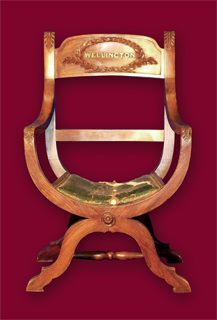
DURING THE BATTLE of Waterloo the Duke of Wellington directed most of the battle from a central position near the crossroads above the farmhouse of La Haye Sainte. As he watched the battle from this vantage point, sitting astride his horse Copenhagen, he was sheltered by the canopy of an elm tree. Although Wellington probably never gave the tree a second thought, after the battle it rapidly became an attraction for British tourists who wanted to take home a relic of the battle, especially one closely linked in any way to the all-conquering duke. Soon the tree was relieved of any embedded musket balls, stripped of its foliage, branches and bark and became a sorry specimen. By 1818 the tree was in such a poor state that the local farmer was preparing to cut the remnants down, to prevent further damage to his cornfields from the endless trail of visitors. However, the tree was actually bought by an enterprising Englishman from the farmer and shipped to Britain to be used to produce a number of wooden pieces.
There are wild claims that the tree was bought by a manufacturer in the Midlands to be turned into numerous tiny items, such as tooth picks and snuff boxes, which could be sold at great profit. However, it has been established that it was actually purchased by a Mr John George Children, a librarian in the British Museum, who by mere chance was visiting the battlefield in September 1818 with his daughter and cousin, the day before the tree was to be cut down. A sketch of the elm tree made by his daughter still survives. In spite of his own modest circumstances, he commissioned Thomas Chippendale the Younger, one of London’s leading cabinetmakers, to create ‘a chair worthy of the occasion’, for the Prince Regent. This was presented to King George IV at Carlton House in 1821.
Date of manufacture:
c. 1882
Location:
Chevening House, Kent, UK
Another chair, with a brass plaque attached claiming its authenticity, came to light recently in Gloucestershire; it went to auction and is now in a private collection. This chair is believed to be one of a pair manufactured in the 1830s with more wood from the tree, with one chair being presented to the Duke of Wellington and the other to the young Queen Victoria. If it is truly one of this pair, it must be the one presented to the queen as the other is known to exist at Apsley House, the London residence of the Duke of Wellington.
Over the years, a large number of other items did appear on the market, claiming to be made from the remaining wood of the tree: a minerals cabinet, work-table, a small stand made by Mr Children himself with the bark still on, to support a bust of the Duke of Wellington. Children disposed of a section of the tree to the Duke of Rutland, a college friend of his, who turned it into a chair too. Beside the three chairs mentioned above, a small table cabinet was sold at auction in 2000 and a writing-table was sold in 2006. It would seem odd that one tree produced such a large number of pieces.


Sir Walter Scott, the poet and avid devotee of Wellington and Waterloo, owned a quaich, or shallow Scottish drinking cup usually with two handles, allegedly made from the wood of the Wellington tree. This was stolen in 1994, along with many other artefacts from Abbotsford House in the Scottish borders, Sir Walter Scott’s home. It was recently discovered in a French antique market and has since been returned to its rightful home.
The complete round of the tree illustrated here is kept in the Stanhope family collection at Chevening House. This is now the official country residence of the foreign secretary for the reception of important international dignitaries and so unfortunately this collection is not available to be seen by the general public. It is possible that this was the same piece mentioned above, produced by Mr Children himself as a base for a bust of the duke.
